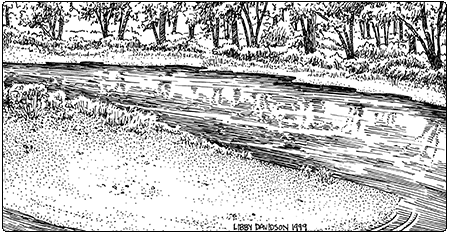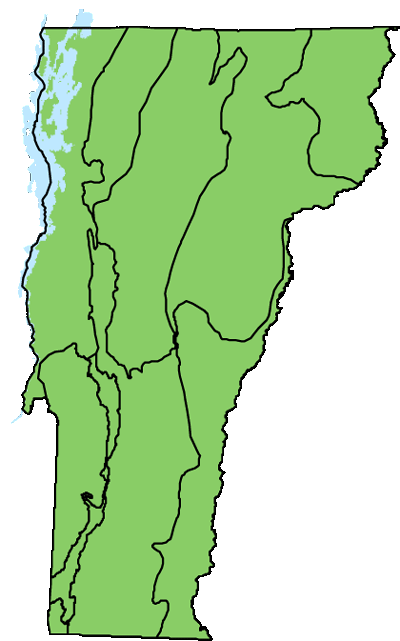Ecology and Physical Setting 
This community occurs on the sparsely vegetated sand and gravel deposits of point bars and islands typical of many Vermont rivers with fast-moving water. These islands and bars might be covered with ice rafts in late spring, and as the ice melts, flattened vegetation becomes visible. By mid-summer they are a mix of bare gravel and lush green vegetation.
River Sand or Gravel Shores are flooded during spring runoff and following heavy rains throughout the year. They typically occur in depositional sections of rivers, such as the downstream portions of inside bends and islands in river channels. In locations where the substrates are coarse and well drained, the community can be quite dry during periods of low river levels. In other locations, where more fine-textured soils mix with the sand and gravel, the substrate may remain moist. Ice scouring, flooding, and shifting substrate are all important factors that keep vegetation sparse.
River Sand or Gravel Shores may occur in association with River Cobble Shores, River Mud Shores, Rivershore Grasslands, Alluvial Shrub Swamps, and floodplain forests.
Vegetation

The lowest, most frequently flooded portions of River Sand or Gravel Shores may be completely devoid of vegetation or may harbor a few herbaceous plants, primarily annuals. Perennials and woody plants are more abundant in the less frequently flooded upper zones. Overall, vegetation cover is generally sparse, but can be more abundant on sunnier shores.
Typical woody plants in the upper zones of this community include sandbar willow, cottonwood, and in the warmer portions of the state, sycamore. Typical herbaceous plants are Indian hemp, grass-leaved goldenrod, big bluestem, little bluestem, fringed loosestrife, blue vervain, and several species of grasses and sedges. In the driest examples, big bluestem and little bluestem—both upland plants—can dominate.
Wildlife Habitat
Several species of tiger beetles are associated with River Sand or Gravel Shores. Tiger beetles are fast runners and aggressive hunters, eating any smaller insects that they can catch. Common shore tiger beetle is a characteristic species of sandy river shores. Its brownish and white markings make it well camouflaged in sand. The very rare boulder-beach tiger beetle and the cobblestone tiger beetle may also be found in this community.
The dusted skipper is a small, rare butterfly that occurs in some River Sand or Gravel Shores where big bluestem and little bluestem grow—these two grasses are the host plants for the butterfly larvae.
Spotted sandpipers use these shores for foraging and nesting. Their nests are shallow depressions on the ground, lined with grass, moss, and feathers, usually close to water and under cover of a small shrub or clump of vegetation. Common nighthawk, a long-distance migrant and aerial insectivore, has declined dramatically over the past few decades and is very rare in Vermont. It is often associated with nesting on flat roof-tops with a pebbly surface, but River Sand or Gravel Shores may be one of its natural nesting habitats.
Several turtles use these sandy and gravelly shores for nesting. Spiny softshells use River Sand or Gravel Shores near Lake Champlain for digging nests and laying eggs. Snapping turtles, painted turtles, and wood turtles nest on a variety of river shores throughout the state.
Related Communities
- River Cobble Shore has much in common with River Sand or Gravel Shore, but the substrate is cobble. River Cobble Shores are typically found on higher gradient river sections.
- Rivershore Grassland typically occurs at slightly higher elevations in the channel than the River Sand or Gravel Shore. The substrate is more stable and the community is more densely vegetated with grasses and herbs.
Conservation Status and Management Considerations
Natural flooding, scouring, and sediment deposition regimes need to be maintained to protect River Sand or Gravel Shores and other rivershore communities. Flood control and power generation dams alter these regimes. The impoundments upstream of these dams act as large settling basins, trapping sediments that would naturally be transported downstream and deposited on point bars or floodplains. Non-native invasive plants are a particular threat to rivershore communities due to the abundance of sunlight and exposed mineral substrate.
Distribution/Abundance 
River Sand or Gravel Shores occur on rivers throughout Vermont. Similar communities occur across eastern North America.
Characteristic Plants
Shrubs and Saplings
Occasional Species
Sandbar willow – Salix interior
Silky willow – Salix sericea
Woolly-headed willow – Salix eriocephala
Cottonwood – Populus deltoides
Sycamore – Platanus occidentalis
Herbs
Occasional to Locally Abundant Species
Indian hemp – Apocynum cannabinum
Grass-leaved goldenrod – Euthamia graminifolia
Big bluestem – Andropogon gerardii
Little bluestem – Schizachyrium scoparium
Fringed loosestrife – Lysimachia ciliata
Blue vervain – Verbena hastata
Twisted sedge – Carex torta
Hidden panic grass – Dichanthelium clandestinum
Witchgrass – Panicum capillare
Northern panic grass – Dichanthelium boreale
Creeping lovegrass – Eragrostis hypnoides
Two-parted cyperus – Cyperus bipartitus
Non-native Invasive Plants
Purple loosestrife – Lythrum salicaria
Japanese knotweed – Fallopia japonica
Pigweed – Chenopodium album
Rare and Uncommon Plants
Hare figwort – Scrophularia lanceolata
Obedience – Physostegia virginiana
Frank’s lovegrass – Eragrostis frankii
Creeping lovegrass – Eragrostis hypnoides
Canada Burnet – Sanguisorba canadensis
Great St. John’s-wort – Hypericum ascyron
Musk flower – Erythranthe moschata
Grass-leaved rush – Juncus marginatus
Redtop panic grass – Coleataenia rigidula
Greene’s rush – Juncus greenei
Associated Animals
Snapping turtle – Chelydra serpentina
Painted turtle – Chrysemys picta
Raccoon – Procyon lotor
Mink – Neovison vison
Spotted sandpiper – Actitis macularius
Variable dancer – Argia fumipennis
Common shore tiger beetle – Cicindela repanda
Twelve-spotted tiger beetle – Cicindela duodecimguttata
Rare and Uncommon Animals
Spiny softshell – Apalone spinifera
Wood turtle – Glyptemys insculpta
Common nighthawk – Chordeiles minor
Dusted skipper – Atrytonopsis hianna
Rapids clubtail – Gomphus quadricolor
Puritan tiger beetle – Cicindela puritana
Cobblestone tiger beetle – Cicindela marginipennis
Boulder-beach tiger beetle – Cicindela ancocisconensis
Ground beetle – Tetragonoderus fasciatus
Places to Visit
River Sand or Gravel Shores are common on the medium-to-high gradient sections of Vermont’s rivers. These are often best accessed by canoe, kayak, or innertube.
Hartland Rivershore Natural Area, Hartland, The Nature Conservancy
White River Wildlife Management Area, Sharon, Vermont Fish and Wildlife Department
Richmond Rivershore Preserve, Richmond Land Trust and The Nature Conservancy
